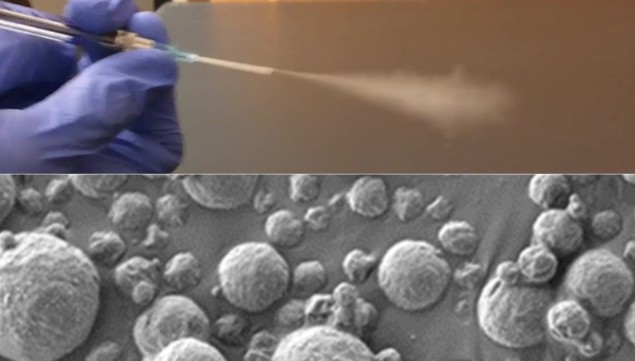
Low-dose CT, the gold standard technique for diagnosing lung cancer in at-risk groups, has reduced lung cancer deaths by 20–25% in clinical trials. Access to this screening technology, however, can be limited in resource-poor settings, leading to disproportionately high lung cancer mortality in such regions. Researchers at Massachusetts Institute of Technology (MIT) hope to address this inequity in early detection of lung cancer with the development of a simple test based on inhalation of nanoparticle sensors.
The new screening test, described in Science Advances, is a needle-free diagnostic platform called PATROL that integrates three modules: activity-based nanosensors (ABNs); a portable inhalation unit; and a multiplexable paper-based lateral flow assay (LFA).
The ABNs are made from polymer nanoparticles coupled with reporters, such as synthetic DNA barcodes, via peptide substrates. To identify a minimal set of probes with high predictive power, the researchers examined a library of candidate peptides that are cleaved upon exposure to cancer-associated proteases. They selected 20 peptides as potential nanosensors and performed tests in mice to identify a combination of four ABNs likely to give accurate diagnostic results.
To undergo a screening test, the patient inhales the ABNs, which are formulated into micron-sized aerosols to optimize deposition in the lungs. If these nanosensors encounter cancer biomarkers, such as lung cancer-associated proteases, the DNA barcodes are cleaved from the particle and released into the circulation, where they eventually concentrate in the urine. These reporters can then be detected using an LFA-based urine test.
To rapidly analyse urine samples without the need for complex lab equipment, the team developed LFAs that can quantify the four different DNA barcodes on a single paper strip at room temperature. And as the nanosensors are delivered using a nebulizer or handheld inhaler, patients can self-administer the PATROL test at home.
“We were really pushing this assay to be point-of-care available in a low-resource setting, so the idea was to not do any sample processing, not do any amplification, just to be able to put the sample right on the paper and read it out in 20 minutes,” says senior author Sangeeta Bhatia in a press statement.
The researchers note that PATROL could have a particularly significant impact in low- and middle-income countries that don’t have widespread availability of CT scanners. “Our goal was to provide a method that can detect cancer with high specificity and sensitivity, and also lower the threshold for accessibility, so that hopefully we can improve the resource disparity and inequity in early detection of lung cancer,” adds co-lead author Qian Zhong.
In vivo assessment
The researchers tested whether the nanosensors can detect lung cancer in mice, examining animals 7.5 weeks after tumours started to form (likely correlating with stage 1 or 2 cancer in humans). They note that while dry powder inhalers offer superior deep-lung deposition in humans, they are breath-actuated and unsuitable for rodents. So instead, they placed the mice in an inhalation tower and exposed them to nebulized nanosensors.
Two hours after ABN inhalation, the researchers collected urine samples from the animals and quantified the reporters using mass spectrometry. They found that substrates exposed to the tumour microenvironment shed the DNA barcodes into circulation, and that urinary signals from all four reporters differed between tumour-bearing and healthy mice. Use of unsupervised algorithmic methods enabled differentiation of all tumour-bearing mice from healthy counterparts.
They concluded that the inhalable ABNs “demonstrate robust power for the early detection of mouse autochthonous lung adenocarcinoma”.
Inhale and detect
Finally, the researchers tested the performance of the entire “inhale and detect” PATROL platform. They synthesized DNA-coded ABNs of approximately 15 nm in diameter and used the same lung cancer mouse model and nebulizer delivery to validate urinary DNA reporter detection using the LFA.
Comparing urinary concentration of each barcode revealed significant differences in the cleavage of three of the reported probes (but not the fourth) between healthy and cancer-bearing mice. Urinary readouts detected with LFA showed similar signal-to-noise ratios to the mass spectroscopy measurements. Again, unsupervised clustering algorithms could classify all of the mice with early-stage lung cancer.
Receiver operating characteristic (ROC) analysis showed that three of the probes acted as competent single classifiers, with area under the ROC curve (AUC) values of 0.82, 0.88 and 0.85. Combining the four probes increased the AUC to 0.93. With 100% specificity, the LFA detected DNA reporters with a sensitivity of 75.2%, comparable to that of micro-CT.

Lung cancer screening dramatically increases long-term survival
The team also examined the safety profile of the inhalable ABNs, and saw no general toxicity or clogging of vasculature in mice seven days after delivering a single dose of ABNs via nebulization.
“Collectively, PATROL holds great clinical potential not only to attain both sensitive and specific lung cancer detection at early stages but also to enable easy deployment in resource-limited settings,” the researchers conclude. Next, they plan to analyse human biopsy samples to see whether the sensor panels can also detect human cancers, hopefully followed by clinical trials in human patients.
- SEO Powered Content & PR Distribution. Get Amplified Today.
- PlatoData.Network Vertical Generative Ai. Empower Yourself. Access Here.
- PlatoAiStream. Web3 Intelligence. Knowledge Amplified. Access Here.
- PlatoESG. Carbon, CleanTech, Energy, Environment, Solar, Waste Management. Access Here.
- PlatoHealth. Biotech and Clinical Trials Intelligence. Access Here.
- Source: https://physicsworld.com/a/inhalable-nanosensors-could-increase-access-to-lung-cancer-screening/



